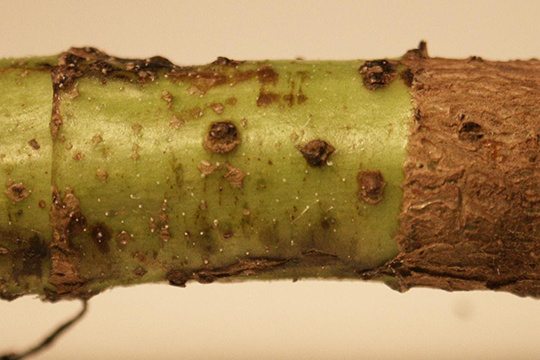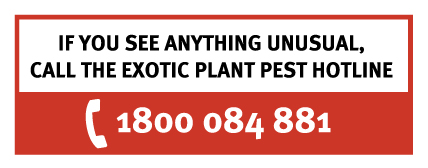




The sunflower stem weevil (Cylindrocopturus adspersus) is a type of beetle which causes significant damage to sunflower. The larvae of the sunflower stem weevil feeds inside the stems of sunflower plants causing significant losses in the Midwest region of the United States. This species is also a vector for the fungal disease charcoal rot (Macrophomina phaseolina) (which is present in Australia) and can predispose plants to infection by the exotic fungal disease phoma black stem (Phoma macdonaldii), which causes premature ripening syndrome
Adult sunflower stem weevils are grey/brown in colour with white spots of varying shape along the thorax and elytra (wing covers) and are 4 to 5 mm in length. Adult females lay eggs in the stem of sunflowers. After hatching the larvae burrow into the pith of the stalk. The larvae are cream in colour with a small brown head capsule. They are up to 6 mm long, legless and are generally c-shaped inside the sunflower stalk. The pupae are generally the same size as the adults and are yellow in colour.
The plant will show symptoms such as decreased vigour or lodging at or slightly above the soil level. Small holes may be visible at the base of the stem where the adult female laid eggs.
In Australia, the sunflower stem weevil may be confused with other weevil species such as the white fringed weevil (Naupactus leucoloma). Lodging can occur due to a variety of different causes. Any larvae found in lodged stems should be investigated further.
Look for the white spotted grey/brown adult weevils at the eight to ten leaf stage. They can be difficult to see as they will drop to the ground when the plant is disturbed and “play dead”. The adults can be found on the lower part of the stem, on both leaf surfaces, on the soil surrounding the plant or within the dried cotyledons. Small holes may also be visible at the base of the stem where the adult female laid eggs. It is also important to investigate any loss of vigour, distorted stems, delayed flowering or lodging. Any signs of charcoal rot or the exotic disease phoma black stem could also indicate a sunflower stem weevil infestation.
Adult sunflower stem weevils are capable of flight allowing for localised spread. It is also possible to sunflower stem weevils to be spread on machinery and vehicles.
The sunflower stem weevil is only known to occur in the United States of America.
You can protect your farm from sunflower stem weevil by regularly checking you property for the presence of new pests and diseases. Check closely for signs of charcoal rot or any lodging of sunflowers. Make sure you are familiar with the symptoms of common pests so you can tell if you see something different.
If you see anything unusual, call the Exotic Plant Pest Hotline on 1800 084 881.

The sunflower stem weevil (Cylindrocopturus adspersus) is a type of beetle which causes significant damage to sunflower. The larvae of the sunflower stem weevil feeds inside the stems of sunflower plants causing significant losses in the Midwest region of the United States. This species is also a vector for the fungal disease charcoal rot (Macrophomina phaseolina) (which is present in Australia) and can predispose plants to infection by the exotic fungal disease phoma black stem (Phoma macdonaldii), which causes premature ripening syndrome
Adult sunflower stem weevils are grey/brown in colour with white spots of varying shape along the thorax and elytra (wing covers) and are 4 to 5 mm in length. Adult females lay eggs in the stem of sunflowers. After hatching the larvae burrow into the pith of the stalk. The larvae are cream in colour with a small brown head capsule. They are up to 6 mm long, legless and are generally c-shaped inside the sunflower stalk. The pupae are generally the same size as the adults and are yellow in colour.
The plant will show symptoms such as decreased vigour or lodging at or slightly above the soil level. Small holes may be visible at the base of the stem where the adult female laid eggs.
In Australia, the sunflower stem weevil may be confused with other weevil species such as the white fringed weevil (Naupactus leucoloma). Lodging can occur due to a variety of different causes. Any larvae found in lodged stems should be investigated further.
Look for the white spotted grey/brown adult weevils at the eight to ten leaf stage. They can be difficult to see as they will drop to the ground when the plant is disturbed and “play dead”. The adults can be found on the lower part of the stem, on both leaf surfaces, on the soil surrounding the plant or within the dried cotyledons. Small holes may also be visible at the base of the stem where the adult female laid eggs. It is also important to investigate any loss of vigour, distorted stems, delayed flowering or lodging. Any signs of charcoal rot or the exotic disease phoma black stem could also indicate a sunflower stem weevil infestation.
Adult sunflower stem weevils are capable of flight allowing for localised spread. It is also possible to sunflower stem weevils to be spread on machinery and vehicles.
The sunflower stem weevil is only known to occur in the United States of America.

You can protect your farm from sunflower stem weevil by regularly checking you property for the presence of new pests and diseases. Check closely for signs of charcoal rot or any lodging of sunflowers. Make sure you are familiar with the symptoms of common pests so you can tell if you see something different.
If you see anything unusual, call the Exotic Plant Pest Hotline on 1800 084 881.